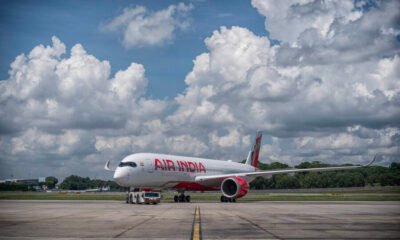Travel Guides & Articles
India's Largest Water Park To Be Built Near Ahmedabad by Imagicaaworld – travelandleisureasia.com

India’s Largest Water Park To Be Built Near Ahmedabad by Imagicaaworld travelandleisureasia.com
Source link
Travel Guides & Articles
‘India’s Marriot is Taj’, Royal Orchid’s forte is India ethos

The company currently operates 7,167 keys across 118 hotels with another 2,500-plus rooms under development, and plans to add about 230 hotels over the next five years, taking the portfolio to 22,000 keys by FY30.
Baljee is clear about how he wants the group to be perceived. “We won’t be India’s Marriott. India’s Marriott is Taj,” he told Mint. “We’re building a distinctly Indian portfolio, with Indian roots and values, present wherever the Indian travels, at home and across the diaspora.”
For him, signing new assets is the easy part. Royal Orchid has “about 60-odd” in the bag and expects to add around 40 properties over the next 12 months, but executing them with the right brand fit and return on capital is what will matter.
At the premium end sits ICONIQA, an upscale lifestyle brand launched in Mumbai, which will be capped at eight hotels by 2030, given the design and investment intensity. Crestoria, a leisure-focused offering, will debut in the hills outside Dehradun shortly and could grow to 25 properties over the next five years.
The mid-market will continue to be led by Regenta and Regenta Place, while the biggest thrust will come from Regenta Z, a tech-first economy franchise that aims to ‘brandify’ India’s unorganised neighbourhood hotels with standardised rooms, hygiene systems and digital rails. “Every neighbourhood in India has a hotel. The dream is to bring them into the fold,” Baljee said. Flexi-lease structures typically involve ₹5-10 crore per asset, but are booked as advance rent recoverable from owners, helping the group scale without straining its balance sheet.
Financial discipline meets growth ambition
Royal Orchid ended FY25 with nearly 10% growth in consolidated income, up to ₹343.18 crore from ₹312.70 crore the year before, while earnings before interest, taxes, depreciation, and amortization (EBITDA) rose modestly to ₹96.8 crore. Net profit eased to ₹47.5 crore as against ₹50.8 crore a year earlier, though return on capital employed improved to 17.3%.
In Q1 of FY26, the company posted a 28% jump in profit after tax to ₹11.2 crore, with consolidated income at ₹82.8 crore, up 6.6% year-on-year. Free cash flow of about ₹55 crore is expected this year, with 40% earmarked for growth and another 40% for internal improvements and brownfield expansions.
Baljee insists that Royal Orchid’s growth filters are straightforward: brands must mean something to guests, execution must be meticulous from design to service, and every project must deliver high returns on capital. “If all three are met, we’ll do the hotel,” he said. Domestic demand is at the core of the plan. “India has 100 million people travelling. International inflow is a bonus,” he added.
The average room rates, he believes, will keep climbing steadily as higher-quality supply enters and independents come under brands. “Record highs will keep getting reset, subject to the world not falling apart.”
GST, infrastructure and the road ahead
While upbeat on growth, Baljee cautioned that tax policy could alter economics in unexpected ways. The reduction of the goods and services tax rate from 12% to 5% for hotels in the lower tier, he said, looks positive at the first glance but carries a hidden sting: the inability to claim input credit on supplies and lease rentals. “It increases operating costs, especially in the mid- and lower-mid market, and may get passed on to customers,” he said.
The company’s network spans 80 cities, but the ambition is to be in all 560 district headquarters and then deepen presence in mature markets. Baljee sees opportunity in both metros and micro-locations: from Amritsar in Punjab, where Royal Orchid already has five hotels and is planning more, to Gujarat’s Kevadia, home to the Statue of Unity, where new demand nodes are emerging.
The company is also betting on India’s growing events economy, from Coldplay weekends to G20-style summits, but Baljee stressed that scalability depends on public transport and venue infrastructure. Around the Mumbai-Ahmedabad bullet train corridor, Royal Orchid is developing a large hotel in Surat to capture the expected surge in demand.
Risks remain familiar: an economic downturn could stall momentum, and execution lapses are a constant challenge in an asset-light model reliant on developers. But Baljee is bullish. “We’ve invested heavily in the team and systems to align on a long-term vision, not just quarterly optics,” he said.
Travel Guides & Articles
8 eco-friendly and sustainable travel tips

Sustainable travel is a new approach to exploring the world, which everyone should adopt to minimize impacts on the environment, culture, and local communities. It helps preserve natural resources and protect wildlife, ensuring minimal disruption to ecosystems for future generations. All travelers should embrace eco-friendly practices to reduce their environmental footprint. Here are some tips that travellers should follow while travelling for a better tomorrow:Choose Sustainable Transportation
Transportation makes a great contribution to the carbon emissions so travellers should reduce the impact by opting for more eco-friendly modes such as buses, trains, cycling or walking whenever possible. It is also advisable that one should opt for slow travel, spend more time at one destination rather than constantly going to one destination or another as this lowers the carbon footprint.Support Local EconomiesOne should prefer accommodations, eateries or shops that are locally owned to keep the revenue of tourism within the community. This practice would greatly help in supporting the livelihoods of local communities, preserve culture and empower small businesses over grand chains. Buy handmade products or crafts as it directly comes from artisans and also helps in reducing the carbon footprint related to mass production.Minimize Waste and Avoid Single-Use Plastics
Utilise reusable water bottles, cloth bags and cutlery that is eco-friendly to reduce utilisation of disposable items. A lot of destinations have already put a ban on plastic bags and straws as this helps in protection of the ecosystem. Proper trash disposal and participation in local clean-up efforts magnify positive impacts.Conserve water and energyOne should not use excessive water and electricity at the place they are staying at. It is important that one turns off lights, fans and air conditioners when the person is not in the room. Utilize reusable towels to decrease the laundry water usage. One should take short showers and avoid wasting a lot of water especially if they are in areas prone to scarcity.Respect Wildlife and Natural HabitatsKeep distance from wildlife, one should not feed them and also avoid touching them or disturbing them. It is advisable that one follows designated trails rather than exploring random areas to prevent habitat damage. Responsible wildlife tourism ensures animal welfare and helps conserve biodiversity for future generations.Offset Carbon Footprint ThoughtfullyTravelers should avoid long-haul flights, which contribute significantly to carbon emissions. Adopting eco-friendly practices also helps minimize environmental harm.Pack Light and Choose Eco-Friendly ProductsUse lighter luggage as it reduces the fuel consumption during transport. Utilise biodegradable toiletries and sunscreens to minimize any chemical pollution. Using durable, reusable travel gear reduces disposable waste throughout a person’s journey.Use Digital AlternativesOne should minimize paper waste by relying more on electronic tickets, boarding passes and digital apps. Many destinations and tour operators now provide apps and online guides which promote sustainable practices.
Travel Guides & Articles
India’s first Vande Bharat Sleeper Express to link Delhi to this city: Check dates and more details

Unlike the existing Vande Bharat Express trains, which are mainly chair-car services suited for day travel, this new model has been designed specifically for overnight trips. With a maximum speed of 180 km/h, the train is expected to halve journey times on long-distance services. For instance, the Rajdhani Express currently takes close to 23 hours to cover the same route.
The Vande Bharat Sleeper has been manufactured using advanced Integral Coach Factory (ICF) technology by Bharat Earth Movers Limited (BEML). It is equipped with a host of modern features including CCTV cameras for enhanced security, LED screens for information and entertainment, automatic doors with sensors for safe boarding, modern fire safety systems and on-board announcement facilities. The interiors have been designed with an aircraft-style finish, giving passengers a premium travel experience.
Also read | Nanded-Mumbai Vande Bharat Express: Fare, timings, route and stations
The train is expected to leave Patna at 8 pm and reach Delhi by 7.30 am the next day, enabling overnight travel and saving time for passengers. The return journey from Delhi will follow a similar overnight schedule. Fares are projected to be 10–15% higher than the Rajdhani Express, but officials suggest that the shorter journey time and upgraded amenities more than justify the difference in cost of the tickets. Compared to flights, the Vande Bharat Sleeper Express offers a pocket-friendly alternative while maintaining high comfort levels.
The Vande Bharat Express, first launched in 2019, has become a flagship service of the Indian Railways. Currently operating on seven routes across the country, these semi-high-speed trains have received strong passenger demand thanks to their speed, safety and comfort. With the introduction of the sleeper version, the government aims to expand the reach of the service, particularly for long-distance routes where overnight travel is common. More sleeper variants and upgraded versions are already in the pipeline, signalling a major transformation in train travel across India.
The Delhi–Patna route is among the busiest in the country, especially during festive seasons when millions of people travel between the capital and Bihar. The Vande Bharat Sleeper Express is expected to ease congestion, provide passengers with a faster travel option, and boost connectivity for both Bihar and Uttar Pradesh. Officials believe this will support regional development by improving business travel and tourism links between north India and the capital.
Also read | Vande Bharat Ticket Booking: Now you can reserve your seat even 15 minutes before departure
(Edited by : Jerome Anthony)
-

 Business1 week ago
Business1 week agoThe Guardian view on Trump and the Fed: independence is no substitute for accountability | Editorial
-
Tools & Platforms4 weeks ago
Building Trust in Military AI Starts with Opening the Black Box – War on the Rocks
-

 Ethics & Policy1 month ago
Ethics & Policy1 month agoSDAIA Supports Saudi Arabia’s Leadership in Shaping Global AI Ethics, Policy, and Research – وكالة الأنباء السعودية
-

 Events & Conferences4 months ago
Events & Conferences4 months agoJourney to 1000 models: Scaling Instagram’s recommendation system
-

 Jobs & Careers2 months ago
Jobs & Careers2 months agoMumbai-based Perplexity Alternative Has 60k+ Users Without Funding
-

 Education2 months ago
Education2 months agoVEX Robotics launches AI-powered classroom robotics system
-

 Podcasts & Talks2 months ago
Podcasts & Talks2 months agoHappy 4th of July! 🎆 Made with Veo 3 in Gemini
-

 Education2 months ago
Education2 months agoMacron says UK and France have duty to tackle illegal migration ‘with humanity, solidarity and firmness’ – UK politics live | Politics
-

 Funding & Business2 months ago
Funding & Business2 months agoKayak and Expedia race to build AI travel agents that turn social posts into itineraries
-

 Podcasts & Talks2 months ago
Podcasts & Talks2 months agoOpenAI 🤝 @teamganassi





















